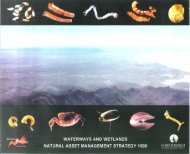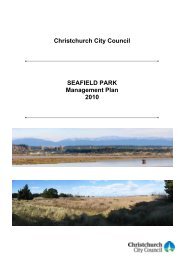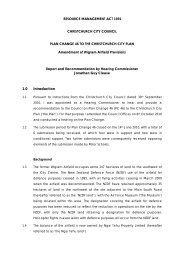Akaroa Historical Overview - Christchurch City Council
Akaroa Historical Overview - Christchurch City Council
Akaroa Historical Overview - Christchurch City Council
Create successful ePaper yourself
Turn your PDF publications into a flip-book with our unique Google optimized e-Paper software.
grounds, was dedicated to the wives of the old pioneers 22 (refer figure 6.7).<br />
The waterfront through these years was a popular place to promenade and rest. It was<br />
well-maintained by the Borough <strong>Council</strong>. “Well cared for garden plots and flower-beds<br />
adorn the waterfront and Britomart reserves” one guide book told prospective visitors.<br />
(The plantings on and use of the waterfront are discussed more fully in the landscape<br />
sections of this report.) 23<br />
Daly’s Wharf, which was used mainly by pleasure boats and launches taking visitors out<br />
on the harbour, was re-opened after it had been reconstructed in February 1915. 24<br />
Figure 6.7. The popularity of swimming and sunbathing among visitors to the resort town<br />
<strong>Akaroa</strong> became in the years between the two World Wars is evident in this photo of the<br />
main beach, probably just before World War II. The Ladies’ Rest Rooms on the foreshore,<br />
visible close to the bathing shed, were built in the early 1930s. Ref: 2182<br />
Industry<br />
It was acknowledged as early as the 1920s that visitors were the economic lifeblood of<br />
<strong>Akaroa</strong>. “The cocksfoot still sometimes waves on the field” the Press declared in 1926<br />
“though it no longer brings wealth; but the township itself now depends largely on the<br />
tourist for its resources.” 25 That industry has never played a significant role in <strong>Akaroa</strong>’s<br />
development has often been celebrated. Andersen wrote in 1927 that “[i]t is a<br />
pleasure ... to know that there is a place of such natural beauty where the ambition is not<br />
to mar it with useful but unbeautiful industries, but rather to preserve such of the natural<br />
beauty that remains, and add to it the parks and gardens of man.” 26<br />
But tourism was far from the sole, or even overwhelmingly important, means of support<br />
<strong>Akaroa</strong> relied on in the first half of the 20 th century. Industry continued to have a small<br />
22 <strong>Akaroa</strong> Mail, 25 October 1933<br />
23 <strong>Akaroa</strong> Tourist Guide Book I, p. 5<br />
24 Ogilvie, Cradle, p. 45<br />
25 The Press, 28 September 1926, Editorial<br />
26 Andersen, Place Names, pp. 43-44<br />
AKAROA HERITAGE OVERVIEW : SECTION 6 YEARS OF STABILITY 1900 TO 1950 PAGE 94
















